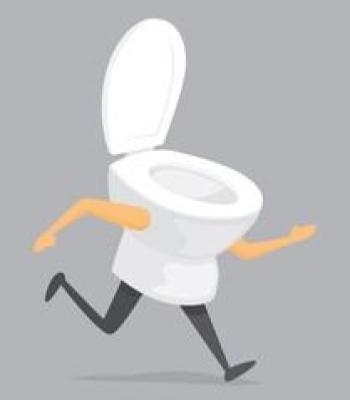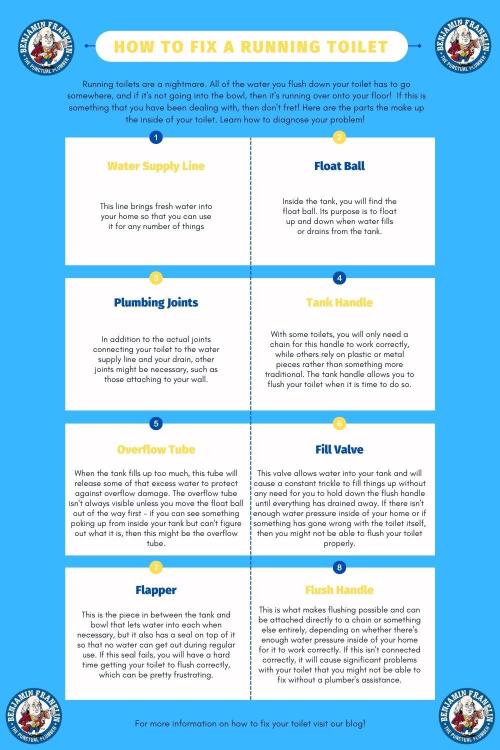
15 Nov How to Fix a Running Toilet
Running toilets are a nightmare. All of the water you flush down your toilet has to go somewhere, and if it’s not going into the bowl, then it’s running over onto your floor! An overflowing toilet can lead to all sorts of problems with mold or mildew development on surfaces near the toilet. If this is something that you have been dealing with for a while now, then don’t fret! Here are some ways to fix a running toilet so that it won’t be an issue anymore.
What Causes a Constantly Running Toilet
Several different issues can cause your toilet to run constantly. If you have noticed that more and more water is running into the bowl, but there’s never anything added to it, then this might be caused by an issue with one of several different parts:
- The Fill Valve – This part controls how much water flows from the tank into the bowl. The chain that connects the fill valve to the handle should have some slack in it, but not so much slack that allows for problems with flushing.
- Flapper – This part is connected by a chain or other mechanism to your toilet’s handle and sits directly on top of the drain where water flows out through the overflow tube. The flapper sits just above this opening so that it can close when you flush and allow water into the bowl but not let it back out again.
- Flush Handle – If your handle seems to be in good working order, but doesn’t seem to do anything at all, then there might be a problem with the linkage between the flush handle and the flapper.
- The Float Ball – If you notice that your toilet seems to flush on its own even when no one has touched it, then there might be a problem with this floating ball getting stuck or broken off of its mount inside the tank. This part controls how much water is allowed into the bowl before it automatically fills back up.
[Additional Reading: What Causes a Running Toilet]
Can a running toilet cause flooding?
A constantly running toilet can lead to flooding. Too much flooding could mean that you have a great deal of water damage inside or outside your house. The water damage could be on the bathroom floor or even outside on surfaces like your patio or driveway.
How to fix a running toilet from overflowing?
If you have a constantly running toilet, then there are several things that you can do to stop it from overflowing. The first step would be replacing any parts in your tank that might not be working correctly or could even potentially cause problems with how your flushing mechanism works. If this doesn’t seem to help and water continues spilling out into your bowl, then you can always try using a plunger.
What are the components of the inside of a toilet?
The first thing that you should know about the inside of your toilet is that it doesn’t just include items like the bowl and tank, even though these are certainly part of things. There are several other components to consider as well before trying to fix your running toilet:
- Water Supply Line – This line brings fresh water into your home so that you can use it for any number of things.
- The Float Ball – Inside the tank, you will find the float ball. Its purpose is to float up and down when water fills or drains from the tank.
- Plumbing Joints – In addition to the actual joints connecting your toilet to the water supply line and your drain, other joints might be necessary, such as those attaching to your wall.
- The tank Handle – With some toilets, you will only need a chain for this handle to work correctly, while others rely on plastic or metal pieces rather than something more traditional. The tank handle allows you to flush your toilet when it is time to do so.
- Overflow Tube – When the tank fills up too much, this tube will release some of that excess water to protect against overflow damage. The overflow tube isn’t always visible unless you move the float ball out of the way first – if you can see something poking up from inside your tank but can’t figure out what it is, then this might be the overflow tube.
- Fill Valve – This valve allows water into your tank and will cause a constant trickle to fill things up without any need for you to hold down the flush handle until everything has drained away. If there isn’t enough water pressure inside of your home or if something has gone wrong with the toilet itself, then you might not be able to flush your toilet properly.
- Flush Handle – This is what makes flushing possible and can be attached directly to a chain or something else entirely, depending on whether there’s enough water pressure inside of your home for it to work correctly. If this isn’t connected correctly, it will cause significant problems with your toilet that you might not be able to fix without a plumber’s assistance.
- Flapper – This is the piece in between the tank and bowl that lets water into each when necessary, but it also has a seal on top of it so that no water can get out during regular use. If this seal fails, you will have a hard time getting your toilet to flush correctly, which can be pretty frustrating.
If you have a running toilet and none of this seems to be the problem, then it’s time to call an experienced plumber near me to handle things for you. They should be able to get your toilet working again in no time. For more education on plumbing, visit the PHCC.

